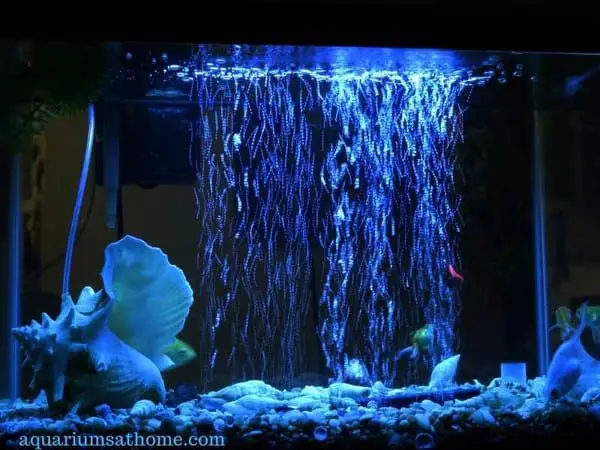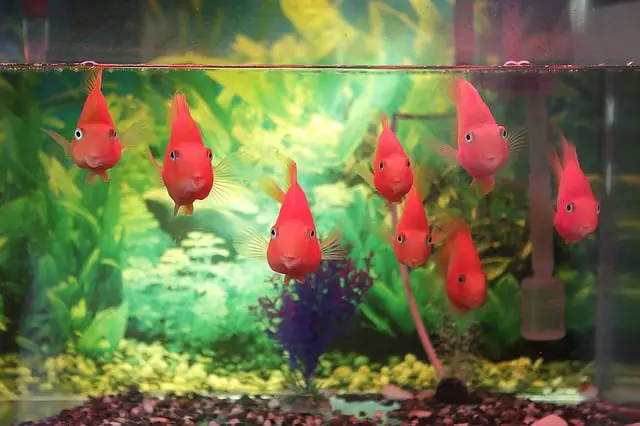As an aquarium hobbyist, you may be contemplating whether to reseal your aging fish tank. Though resealing is usually only done on aquariums that are 10 years old or more, you may be wondering if it’s time or how to know for sure when your tank needs to be resealed?
You’ll know it’s time to reseal your aquarium if the silicone is cracking or peeling away. Water leaks along the glass panel joints is yet another telltale sign. If you’ve purchased your fish tank used and aren’t sure how old it is, then resealing it before setting it up is recommended.
Now that you know how to recognize if (and when) your fish tank needs resealing, let’s explore this topic further. I’ll explain how long fish tank sealant lasts, how to remove old sealant, and how to replace sealant yourself using a simple 10-step method. I’ll also discuss how to fix leaks without completely draining your tank, which silicone product is best, and how often you should reseal your tank.
So, if you’re ready to learn more about maintaining and repairing aquariums, then let’s begin!
How Long does Aquarium Sealant Last?
Fish tank sealant is composed primarily of silica (preferably non-toxic silicone), which is highly durable and takes a very long time to break down. Aquarium sealant should last for at least 10 years or more, depending on the tank and how well it’s maintained.
If your fish tank was manufactured within in the past 5 years, the silicone used to seal it should last for at least 15 to 20 years! An older or unkept aquarium, on the other hand, will most likely need resealing after 10 to 12 years.
How Often Must I Reseal My Aquarium?
I’ve read that some aquarium hobbyists like to reseal their fish tanks every 5 to 10 years. Depending on how old the tank is, if it’s a salt or freshwater aquarium, and how well you maintain it will all determine how often you’ll need to reseal the glass panel joints.
My recommendation is to reseal only if the tank needs it – meaning, you can see water leaking or feel moisture along the seams! If you do the work yourself, be sure to use a 100% pure silicone product with no additives like Aqueon Silicone Aquarium Sealant available online through Amazon.
Does Sealant Last Longer on Freshwater or Saltwater Tanks?
In general, sealant on a freshwater aquarium will likely last longer than that of a saltwater tank. The minerals in saltwater can break down silica faster and cause it to crack and/or peel away. In some cases, the necessary scrubbing action used to clean algae off the tank walls can inadvertently tear away strips of silicon along the glass panel joints.

How do I Know if My Aquarium Seal is Good?
You’ll know that your aquarium seal is good if there aren’t any air bubbles in it and the silicon has been applied both smoothly and evenly. As well, check the glass panel joints and if you can’t see any water dripping down or feel any moisture, then it’s fine.
Should You Reseal a Used Aquarium?
When in doubt of either how old it is or the condition it’s in, you should reseal a used aquarium. If you don’t, you run the risk of adding water and fish to the tank only to have it leak and/or crack. This could not only cause damage and make a huge mess, but also endanger the lives of your aquatic pets. Better to be safe than sorry!
How do You Remove Aquarium Sealant?
It’s best to remove aquarium sealant completely with a straight razor or utility knife and then use some acetone on a cloth to wipe away any leftover silicone. The cleaner (and dryer) the area is, the better the new sealant will adhere to the glass panel joints. Just be very careful when using a bladed tool so as not to cut and/or seriously injure yourself!
How Much does it Cost to Reseal an Aquarium?
If you opt to reseal a fish tank yourself, the fee is merely that of the silicone product. Around $20 is all should it cost you to get the job done – assuming, that is, you already have a utility knife or straight razor on-hand as well as come acetone, glass cleaner, paper towels, and a cloth.
How do You Reseal an Aquarium?
To reseal an aquarium, follow these 10 simple steps:
- Begin by removing all fish and placing them in a separate tank.
- Completely drain the aquarium.
- Wipe down the tank thoroughly to ensure it’s both clean and dry.
- Remove any old or cracked sealant carefully using a straight razor.
- Apply acetone to a cloth and wipe all along the joints, removing any residual sealant.
- Apply a smooth ¼” bead of aquarium sealant along the outside joint – repeat this process along the inside joint – make sure the seal is bubble-free.
- Move around the tank and apply the sealant to all remaining joints as outlined above.
- Allow 24 to 48 hours for sealant to cure fully.
- Refill the tank slowly (3 inches at a time) to ensure the seam is secure.
- Cycle and treat the tank water properly before reintroducing your fish.

How do I Fix a Leaking Aquarium without Draining it?
To fix a leaking aquarium without draining completely, follow the 8 steps listed below:
- Begin by removing your fish and placing them in a separate aquarium.
- Take a bucket and remove some water from the tank – just to the point of where the leak is.
- Scrape off the old sealant from the leaking glass joint with a razor blade.
- Use some solvent and a cloth to remove any excess silicone.
- Take a caulking gun and apply 100% pure silicone evenly to the joint about ¼” thick – make sure there aren’t any bubbles in the sealant.
- Allow enough time for the sealant to dry completely – approximately 1 to 2 days.
- Refill the tank gradually with pretreated water and watch for leaks.
- If there aren’t any leaks after a few hours, proceed with reintroducing your fish to the tank.
Take note: Fixing a leaking aquarium without draining it is, at best, a band-aid solution and won’t resolve the problem for long. You can apply silicon along the outside joints only, but this won’t provide a secure or thorough seal. For the tank to be structurally sound, the seal must be repaired on the inside as well.
Conclusion
To conclude, it’s time to reseal your fish tank if it’s more than 10 years old and the silicone along the glass panel joints appears to be cracking or peeling away. Weakened seals will ultimately cause your tank to leak, which can be dangerous your aquatic pets. Therefore, watch for wet spots around the aquarium and opt to reseal it if unsure of its structural integrity.
I trust this article has answered your questions pertaining to fish tank maintenance and repair. Thanks for reading and good luck with your aquarium hobby.
Related Posts
Why Do Fish Tanks Crack? [2 Causes Identified]
How Long Do Fish Tanks Last? (Glass Versus Acrylic)
How Long Can an Aquarium Sit Empty?
Can a Fish Tank Cause Allergies?




